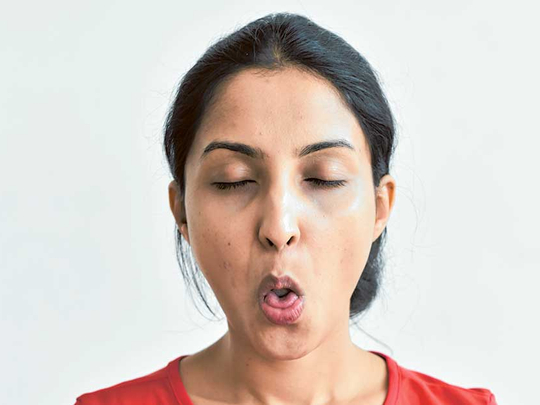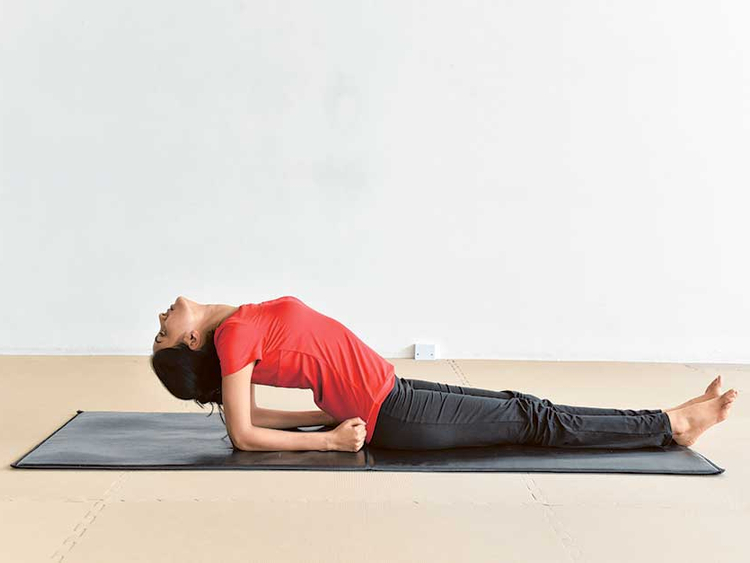
The next two pranayama techniques include sheetali (cooling breath) and seetkari (hissing breath). These techniques are particularly helpful to cool the body during the summer season and when fasting during Ramadan.
When you practise these techniques, cool air reaches the lungs whereas when you breathe normally, the air that reaches the lungs is at a higher temperature. The vagus nerve which is attached to the lungs and brain communicates the cooling sensation, as a result of which relaxing hormones are released improving the homeostasis in the body.
Sheetali Pranayama
Sit in any comfortable meditative posture with hands placed in chin mudra (Yoga: Understanding Pranayama Part 5). Keep your spine, neck and chin upright. Close the eyes and relax the whole body.
Extend the tongue outside the mouth as far as possible without strain. Roll the sides of the tongue up so that it forms a tube.
Inhale and draw the breath in through this tube. The breath should produce a noise similar to rushing wind.
At the end of inhalation, draw the tongue in, close the mouth and hold your breath for 10 seconds. Exhale slowly through the nose. A feeling of coldness will be experienced on the tongue and the roof of the mouth. This is one round. Practise 10-12 rounds.
About one third of the world population is genetically incapable of rolling the sides of the tongue into a tube. In such cases, Seetkari Pranayama gives similar benefits.
Seetkari Pranayama
Sit in any comfortable meditative posture with your spine, neck and chin upright. Hands remain in chin mudra.
Hold the teeth lightly together. Separate the lips, exposing the teeth. The tongue may be kept flat or folded against the soft palate inside. Breathe in slowly and deeply through the teeth. At the end of the inhalation, close the mouth, keeping the tongue either flat or folded up.
Hold the breath for 10 seconds. Breathe out slowly through the nose, in a controlled manner. This is one round. Practise 15 to 20 rounds.
For further benefits, these techniques can be practised with Jalandhar bandha (throat lock). This is a neuro-muscular lock which works on the thyroid gland. It helps restore hormonal balance in the body. While you hold the breath, lock the chin to the chest at the jugular notch. Jugular notch is in the dip in the clavicular bone. Hold for the same duration of 10 seconds, lift the chin up and exhale. It is important to stretch the throat while contracting the neck as shown in matsyasana (fish pose) in order to ease any tension. (Read: Bandhas)
Benefits
- The techniques help in case of reflux, hypertension, ADHD (attention deficit hyperactivity disorder), insomnia, anxiety and anger management.
- These techniques are excellent for people who suffer from headaches or migraine.
- They give control over hunger and thirst.
- An additional benefit of Seetkari Pranayama is it keeps the teeth and gums healthy.
Keep in mind
- People suffering from low blood pressure, throat infection or respiratory disorders such as asthma, bronchitis and excessive mucus should not practise these techniques.
- People suffering from chronic constipation should also avoid them.
- Generally, these techniques should not be practised in winter or in cool climate areas. Choose a clean place. Avoid outdoors or dusty and polluted atmosphere.
- Practitioners with sensitive teeth, missing teeth or dentures should avoid Seetkari Pranayama.
Practice of the week
Sheetali
Seetkari
Matsyasana
Next week: Understanding Pranayama part 7
— This is an interactive series, in which we bring you practical tips on daily living, inspired by the vision of yoga. Write in to tabloid@gulfnews.com with your questions and doubts regarding enhancing your lifestyle through yoga. For more information, call 800-YOGA (9642) or log on to artisticyoga.com















